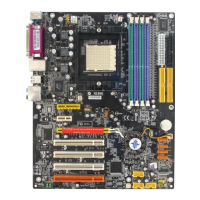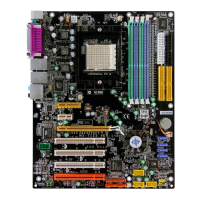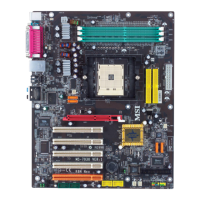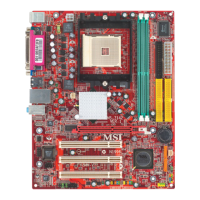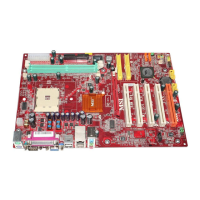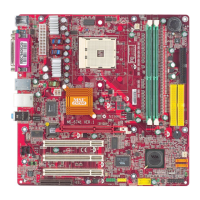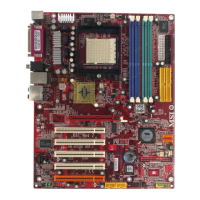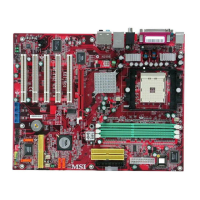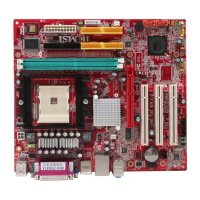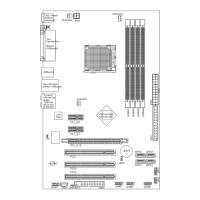Do you have a question about the MSI K8NGM-V and is the answer not in the manual?
Details the technical specifications of the K8NGM2 Series mainboard, including CPU, chipset, memory, and slots.
Lists and describes the various connectors and ports integrated onto the mainboard for connectivity.
Illustrates the typical items included in the mainboard package, noting variations based on purchase.
Provides a visual diagram of the mainboard with labels and page references for each component.
Explains how to install the AMD Athlon64 processor and its cooling system, emphasizing safety precautions.
Details the mainboard's memory slots and guidelines for installing DDR DIMM modules for dual-channel operation.
Describes the ATX 24-pin and 12V power connectors, including pin definitions and recommendations.
Details the rear I/O ports such as PS/2, VGA, USB, LAN, and audio jacks, with pin definitions.
Explains various internal connectors like FDD, fan headers, IDE, SATA, audio, and panel connectors.
Describes the PCI Express and PCI slots, including interrupt request routing for expansion cards.
Instructions on how to enter the BIOS setup utility during system boot-up, including control keys.
Overview of the BIOS main menu structure and how to navigate through setup options.
Configuration settings for system date, time, and primary IDE/SATA devices.
Detailed settings for chipset and memory configurations to optimize system performance.
Enables/disables onboard devices like USB, IEEE1394, audio, LAN, and IDE/SATA controllers.
Settings for ACPI, standby states, power button functions, and wake-up events.
Configures Plug and Play (PnP) and PCI bus settings, including IRQ and DMA resource allocation.
Displays system status including CPU, fan speeds, voltages, and temperatures for hardware monitoring.
Overview of the DigiCell utility's main screen and its various functional buttons.
Guides on configuring wireless network access point modes, security, and channels.
Explains how to use Live Update to automatically detect and update BIOS, drivers, and utilities online.
Describes the PC Alert feature for real-time monitoring of hardware status, temperatures, and fan speeds.
Details how to schedule system power-on, power-off, and auto-execution of programs.
Specifies the operating systems supported by NVRAID and outlines the different RAID array types.
Step-by-step guide for configuring NVRAID arrays in the BIOS and installing necessary drivers.
Explains tasks like viewing configurations, setting spare disks, creating, deleting, and rebuilding RAID arrays.
Process for initializing RAID arrays, which erases data and prepares disks for consistent performance.
Instructions on restoring data from other drives in the array, applicable to fault-tolerant RAID levels.
Guides on installing the Realtek HD Audio driver for Windows 2000/XP to enable multi-channel audio.
Details how to activate HD Audio Configuration and adjust sound settings via the system tray or Control Panel.
Explains how to adjust individual speaker volumes, enable multi-stream playback, and use mixer settings.
Guides on configuring speaker output channels (2/4/6/8-channel) and 'retasking' jacks for different functions.
Options for enhancing microphone input, including noise suppression and acoustic echo cancellation.
Step-by-step instructions for physically installing the TV-Out bracket onto the mainboard and system case.
Guides on connecting S-Video, RCA, and HDTV cables from the TV-Out bracket to a display device.
Procedures for configuring display settings in Windows XP to enable and optimize TV-Out output.
Details the technical specifications of the K8NGM2 Series mainboard, including CPU, chipset, memory, and slots.
Lists and describes the various connectors and ports integrated onto the mainboard for connectivity.
Illustrates the typical items included in the mainboard package, noting variations based on purchase.
Provides a visual diagram of the mainboard with labels and page references for each component.
Explains how to install the AMD Athlon64 processor and its cooling system, emphasizing safety precautions.
Details the mainboard's memory slots and guidelines for installing DDR DIMM modules for dual-channel operation.
Describes the ATX 24-pin and 12V power connectors, including pin definitions and recommendations.
Details the rear I/O ports such as PS/2, VGA, USB, LAN, and audio jacks, with pin definitions.
Explains various internal connectors like FDD, fan headers, IDE, SATA, audio, and panel connectors.
Describes the PCI Express and PCI slots, including interrupt request routing for expansion cards.
Instructions on how to enter the BIOS setup utility during system boot-up, including control keys.
Overview of the BIOS main menu structure and how to navigate through setup options.
Configuration settings for system date, time, and primary IDE/SATA devices.
Detailed settings for chipset and memory configurations to optimize system performance.
Enables/disables onboard devices like USB, IEEE1394, audio, LAN, and IDE/SATA controllers.
Settings for ACPI, standby states, power button functions, and wake-up events.
Configures Plug and Play (PnP) and PCI bus settings, including IRQ and DMA resource allocation.
Displays system status including CPU, fan speeds, voltages, and temperatures for hardware monitoring.
Overview of the DigiCell utility's main screen and its various functional buttons.
Guides on configuring wireless network access point modes, security, and channels.
Explains how to use Live Update to automatically detect and update BIOS, drivers, and utilities online.
Describes the PC Alert feature for real-time monitoring of hardware status, temperatures, and fan speeds.
Details how to schedule system power-on, power-off, and auto-execution of programs.
Specifies the operating systems supported by NVRAID and outlines the different RAID array types.
Step-by-step guide for configuring NVRAID arrays in the BIOS and installing necessary drivers.
Explains tasks like viewing configurations, setting spare disks, creating, deleting, and rebuilding RAID arrays.
Process for initializing RAID arrays, which erases data and prepares disks for consistent performance.
Instructions on restoring data from other drives in the array, applicable to fault-tolerant RAID levels.
Guides on installing the Realtek HD Audio driver for Windows 2000/XP to enable multi-channel audio.
Details how to activate HD Audio Configuration and adjust sound settings via the system tray or Control Panel.
Explains how to adjust individual speaker volumes, enable multi-stream playback, and use mixer settings.
Guides on configuring speaker output channels (2/4/6/8-channel) and 'retasking' jacks for different functions.
Options for enhancing microphone input, including noise suppression and acoustic echo cancellation.
Step-by-step instructions for physically installing the TV-Out bracket onto the mainboard and system case.
Guides on connecting S-Video, RCA, and HDTV cables from the TV-Out bracket to a display device.
Procedures for configuring display settings in Windows XP to enable and optimize TV-Out output.
| Brand | MSI |
|---|---|
| Model | K8NGM-V |
| Category | Motherboard |
| Language | English |

